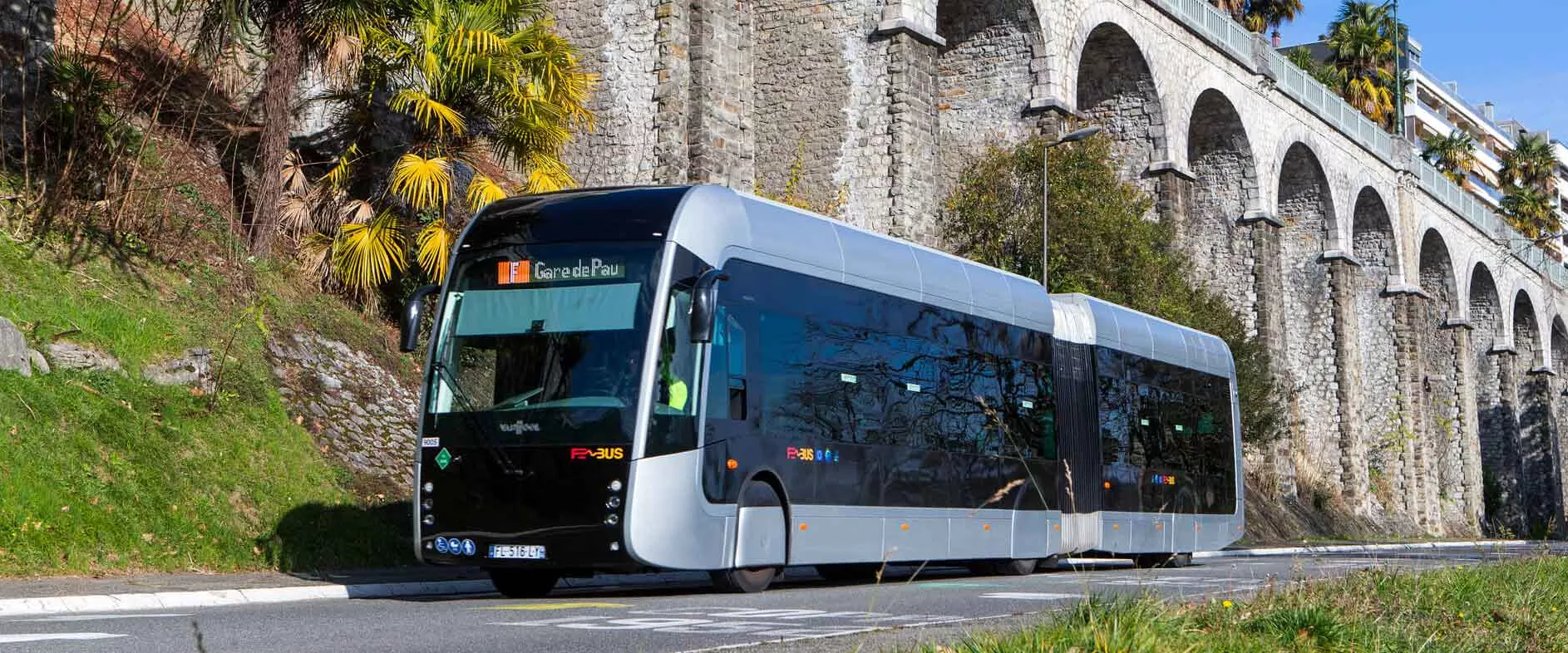
Aboard the world’s 1ˢᵗ hydrogen-powered BRT
Inaugurated in December 2019 and operated with technical assistance from our Keolis subsidiary, the hydrogen-powered Fébus bus rapid transit (BRT) network has transformed everyday travel for residents of the south-western French city of Pau.
Re-inventing bus transport
The big glass doors open, and passengers board the bus at both front and rear, each contactless ticket validated with a single beep. The smell of new leather is in the air. Once everyone is seated, the bus sets off, silently travelling up the steep streets of the old city with stops at 14 strategic locations: municipal offices, universities, shops, the hospital, the railway station and more.
With its fleet of eight new BRT buses, the Fébus network has repeated this daily routine every 8-10 minutes since 17 December 2019, when it was launched by Idelis—Pau’s public transport network—with technical assistance from our subsidiary Keolis.
Light rail on wheels
The new system has a lot to offer. Pau railway station, on the south side of the city, and François-Mitterrand Hospital, on the north side, are 6 km apart: Fébus covers that distance in just 17 minutes, with the superior comfort and service that passengers can expect from light rail.
The new line is a success, according to Diana, a temporary worker in aeronautics production who’s familiar with Pau’s bus service. “I can buy my ticket at the bus station and get real-time traffic updates from the app or at the stops. The buses come frequently, and there’s plenty of room on board. They’re so comfortable and reliable, it really feels like riding a tram in Bordeaux,” says the former Bordeaux native, who moved to the Pau area in the summer of 2019.

8
hydrogen-powered Fébus buses serve Pau 7 days a week

1
bus every 8 minutes in peak periods

18m
Fébus buses are 18m long by 2.5m wide and weigh 19 tonnes.
Sleek elegance and passenger service
The sleek black-and-grey buses measure 18m long by 2.5m wide and weigh 19 tonnes. Specially created for the city of Pau by Belgian manufacturer Van Hool and designer Julian Gaubert, Fébus is a model of understated style.
The ergonomic seats are covered in saddle-coloured leather, with wooden tray tables and power points on either side. “It’s really convenient when my battery is running low,” says Thomas, smartphone in hand. “And they’re a lot more comfortable than the old T2 buses. It’s still crowded at rush hour, but the dedicated bus lanes save us a lot of time,” adds this 24-year-old accounting student, as our Fébus sets off briskly from the Condorcet-University station with a crowd of students aboard.
Fast and affordable
“They’re cooler, they’re bigger, they’re easier—and at €1 a ticket, the price is right. Plus we don’t have to wait behind lines of cars at traffic lights,” says 25-year-old Zélim, an apprentice pastry-cook enrolled at the local vocational college. With dedicated lanes accounting for 85% of the route, free park n’ ride facilities to encourage motorists to leave their cars behind, and priority at traffic lights and roundabouts, Fébus is much faster than a conventional bus line.
At the back of the bus, Suzanne, 82, and Emmanuelle, 40, are discussing the system’s accessibility for people with limited mobility. “Having the bus pull up at platform level is a real plus,” says Emmanuelle, her arms full of shopping. “But I’ve never lived in a city with trams, so I still don’t have the nerve to board at the back. It’s probably just habit!” “I’ll get on anywhere—just as long as they don’t leave me on the platform,” replies Suzanne with a smile. A retiree, she takes Fébus “three times a week” to attend her “exercise and yoga classes” and to go for strolls in the city centre.
A name from the past, power from the future
But you won’t notice the new system’s most remarkable innovation immediately. The buses are named after the powerful 14th-century nobleman Gaston III, Count of Foix and Viscount of Béarn, who adopted the nickname “sun god”—Phoebus or Fébus, as it was written in Occitan, then the language of the region. So a nod to the past, although the innovative technology that powers them points clearly toward the future. Hidden in the roof of each BRT is a hydrogen fuel cell that generates the energy for its electric motor.
This technology, never before used in an 18-metre bus, emits no greenhouse gases—only water vapour—and enables each Fébus to cover 240 km per day without refuelling. “Fébus hasn’t revolutionized my life, but I do care about the environment. If choosing this bus over other forms of transport can help the planet even a little, that’s a good thing,” says Emilien, 27.

1,000L
Fébus releases 1,000 litres of water (in the form of vapour) every day

2t
It releases 2 tonnes of oxygen a day—as much as a 62-ha forest releases in a year
€74 million
In all, the Fébus project required €74 million in investments.
Made in Pau: Generating hydrogen
To launch this innovative BRT line, the city had to build a station to produce and distribute hydrogen fuel. Located in Pau’s Idelis bus depot and inaugurated in September 2019, it generates up to 268 kg of hydrogen a day.
How? An electrolyser uses electricity to break water molecules down into their components: oxygen and the hydrogen needed to power the buses. For now, the station runs on electricity from the local grid, but soon it will draw energy directly from solar panels set up nearby—a green and fully renewable power supply.
Share the article